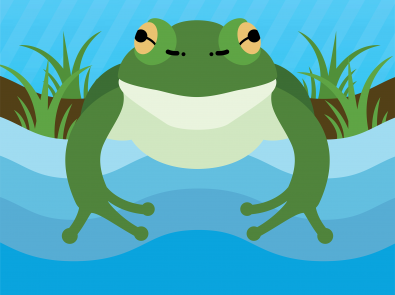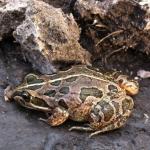This lesson plan focuses on the growling grass frog (Litoria raniformis), building students' understanding of frog biology and the process of urbanisation to help them identify future urban growth hotspots that will impact frog habitat.
Students will then be able to evaluate and make decisions on the best way to manage urban growth, specifically through the use of habitat corridors.
Frogs are a class of animals in our urban habitats that are often overlooked when studying the impacts of urban growth on biodiversity. The growling grass frog was once very common in Melbourne, but due to a significant decline in numbers is now considered endangered. This decline can be attributed to habitat fragmentation caused by urban growth, and the impacts of Chytrid fungus.
Download the lesson plan
This lesson plan contains modules explicitly linked to the Victorian Curriculum, as well as meaningful and effective extension activities for frog conservation. To receive free hard copy classroom resources and additional support, email [email protected].
Activities
These activities can be used individually or in sequence.
Activity 1: How is urban growth changing Melbourne and its frogs?
Students look at nature and extent of past, current and future urban growth in Melbourne using satellite imagery––and the impact this has had on frog numbers.
Activity 2: Conducting a frog census in our local area—excursion or at-home activity
Students participate as citizen scientists in the Frog Census by identifying current urban growth fringe regions and recording frog data at these locations.
Activity 3: Where are the future of growling grass frog habitats in Melbourne?
Students use criteria to determine the location of current and future habitats of growling grass frogs in Melbourne. They then make predictions about which of these habitats would be most threatened using the Atlas Living Australia (ALA) and urban growth models.
Activity 4: Creating habitat corridors to manage future frog habitats
Students use the Atlas of Living Australia (ALA) and criteria to determine the location of a possible habitat corridor. Students then create an interactive map using Google My Maps to map the distribution of the growling grass frog, the location of their chosen habitat corridor and present a justification for their choice.
Victorian curriculum links
- VCGGK144: Different types and distribution of environmental changes and the forms it takes in different places
Geography > Geographical knowledge > Environmental change and management - VCGGK145: Environmental, economic and technological factors that influence environmental change and human responses to its management
Geography > Geographical knowledge > Environmental change and management - VCGGC128: Identify, analyse and explain significant spatial distributions and patterns and identify and evaluate their implications, over time and at different scales
Geography > Geographical concepts and skills > Place, space and interconnection - VCGGC131: Select, organise and represent data and information in different forms, including by constructing special purpose maps that conform to cartographic conventions, using digital and spatial technologies as appropriate
Geography > Geographical concepts and skills > Data and information - VCGGC132: Analyse and evaluate data, maps and other geographical information using digital and spatial technologies and Geographical Information Systems as appropriate, to develop identifications, descriptions, explanations and conclusions that use geographical terminology
Geography > Geographical concepts and skills > Data and information - VCDTDI048: Analyse and visualise data to create information and address complex problems, and model processes, entities and their relationships using structured data
Digital technologies > Data and infomation
Resources
Frog Census app
Get involved in our community frog monitoring program, and collect data to help us manage frog populations and raise awareness of waterway health issues with our Frog Census app.

